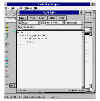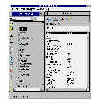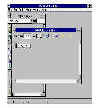O
racle Forms are a development tool that can
be used to create applications to enter, access, change, or delete data from an Oracle
database in an online, form-based environment. Forms has provided many objects for
developing an effective application module. Coupled with the concept of user
extensibility.
The Oracle Forms Environment
Oracle Forms operates in a graphical user interface (GUI) environment
such as Microsoft Windows 3.x. The primary tools used to develop customized forms are the
Object Navigator, the Layout Editor, and the object property sheets. In addition to online
forms, Oracle Forms are also used to create and maintain application menus and program
unit libraries.
The Object Navigator
 The Object Navigator
presents all the elements that combine to create an Oracle Forms application module. These
elements (or objects) may be manipulated using the iconic buttons and menu options. Within
the Object Navigator, the application components are presented to the developer in a
hierarchical outline format indicating the organization of the form elements.
The Object Navigator
presents all the elements that combine to create an Oracle Forms application module. These
elements (or objects) may be manipulated using the iconic buttons and menu options. Within
the Object Navigator, the application components are presented to the developer in a
hierarchical outline format indicating the organization of the form elements.
Triggers
 Triggers are PL/SQL functions that will be
executed based on some specific activity or condition in the form. These activities,
called events, are the foundation of Oracle Forms' user extensibility feature. While many
of the trigger events will perform a particular default function, a trigger can be written
to disable, modify, or enhance the default processing capabilities associated with the
event. Triggers can be defined at the form, block, record, or individual field level. In
addition, a trigger may cause another trigger to "fire" as well as execute
another related program unit.
Triggers are PL/SQL functions that will be
executed based on some specific activity or condition in the form. These activities,
called events, are the foundation of Oracle Forms' user extensibility feature. While many
of the trigger events will perform a particular default function, a trigger can be written
to disable, modify, or enhance the default processing capabilities associated with the
event. Triggers can be defined at the form, block, record, or individual field level. In
addition, a trigger may cause another trigger to "fire" as well as execute
another related program unit.
Alerts
 Alerts are used to provide
additional information or other messages that require response or acknowledgment from the
user. An alert may contain one to three buttons that can be used to define the action the
user wants to execute based on the condition.
Alerts are used to provide
additional information or other messages that require response or acknowledgment from the
user. An alert may contain one to three buttons that can be used to define the action the
user wants to execute based on the condition.
Attached Libraries
Libraries are special Oracle Forms modules that can be defined to
contain reusable procedures and functions. By attaching program unit libraries to a form,
the program code can be maintained in a single file rather than in each individual form
module. Libraries help to assure the quality of an application by ensuring that all
modules follow the same set of business rules.
Blocks
 A block in a form generally
corresponds to an individual entity (table, view, or snapshot) in the database.
Additionally, blocks may be created that do not correspond to any table. These blocks,
called non-base table blocks, are usually used to hold generic control information, such
as query criteria, counters, conditional indicators, and other information that may relate
to more than one record or activity.
A block in a form generally
corresponds to an individual entity (table, view, or snapshot) in the database.
Additionally, blocks may be created that do not correspond to any table. These blocks,
called non-base table blocks, are usually used to hold generic control information, such
as query criteria, counters, conditional indicators, and other information that may relate
to more than one record or activity.
Items
Items are grouped in the Object Navigator within their respective
blocks. An item corresponds to a single data element or field. These items may contain
database columns or may be used as containers for other related data.
Relationships
Relationships are defined according to how the separate blocks in a
form relate to each other. Typically in a multiple block form, one block is usually
defined as the primary or master table, and the other blocks display detail information
associated with the current record in the master block.
Canvas-Views
 A canvas is the virtual
structure where the form objects are laid out. For the most part, canvases are defined as
either content or stacked canvases. A content canvas is displayed in its entirety within
the form window. Whenever a content canvas is first displayed, any other canvases will be
hidden in the window. A stacked canvas, on the other hand, will display "on top"
of any existing canvases within the form window.
A canvas is the virtual
structure where the form objects are laid out. For the most part, canvases are defined as
either content or stacked canvases. A content canvas is displayed in its entirety within
the form window. Whenever a content canvas is first displayed, any other canvases will be
hidden in the window. A stacked canvas, on the other hand, will display "on top"
of any existing canvases within the form window.
Editor
An editor is a window for viewing and maintaining large data fields.
These fields are sometimes included for the entry of user comments or other information
that would not normally fit in a displayed item.
LOVs
 LOVs (also called lists of
values) provide the user with a list of valid entries for a field. A list of values
presents data contained within an object called a record group whereby the user will
select one value from the list to populate a form item. The list of values may also be
used to validate user input to ensure that a valid value is entered.
LOVs (also called lists of
values) provide the user with a list of valid entries for a field. A list of values
presents data contained within an object called a record group whereby the user will
select one value from the list to populate a form item. The list of values may also be
used to validate user input to ensure that a valid value is entered.
Object Groups
An object group is a special mechanism for packaging several form
objects into a container, which may then be used in other forms with a minimum of
programming. Once an object group is created in a form, any of the form objects may be
copied into the object group.
Parameters
Parameters may be defined for a form in order to provide a startup
input for the form. Typically, parameters are used to pass values from one form to a newly
called form in a multiple-form application. Prior to the Developer/2000 tools, the only
way to pass values between forms was through the use of global variables that tended to
use up available memory.
Program Units
Program units are PL/SQL procedures and functions that can be called by
the form triggers. A program unit is equivalent to the third generation programming
concept of subroutines. A typical candidate for definition of a program unit is a segment
of program code that is used by more than one trigger. Program units should also be used
to modularize long code segments.
Property Classes
 A property class defines
the properties of a class of objects. In cases where many form objects have identical
properties, a property class benefits the developer by ensuring that the objects are
consistent. Additionally, property classes can be used to enforce standards and to
accelerate the development time for a form module.
A property class defines
the properties of a class of objects. In cases where many form objects have identical
properties, a property class benefits the developer by ensuring that the objects are
consistent. Additionally, property classes can be used to enforce standards and to
accelerate the development time for a form module.
Visual Attributes
An object's visual attribute defines the color, font, and style
characteristics for an item. While each of these values can be set individually for each
object, the visual attribute provides a mechanism to define a valid combination of visual
characteristics for a form. A high-quality application should not use many different
visual attributes within the items.
Windows
A window is the frame within which a form appears on the user's screen.
Each canvas is assigned to a specific window in the form and several canvases may be
assigned to the same window. A single form can contain several windows or it may consist
of only one window.
Object Properties Sheets
The characteristics of each element in a form are defined by its
various properties. A context-sensitive property sheet exists for each component, based on
the type of object that is being defined. The scroll bar at the right side of the property
sheet is used to navigate through the property sheet, and the iconic buttons at the top
are used to control activities in the sheet.
The Layout Editor
The Layout Editor presents the canvas on which the form objects are
laid out. This tool is operated through the use of iconic buttons and menu choices. The
buttons along the left side of the Layout Editor window are used to create and manipulate
the form layout objects.
Customizing the Forms Environment
Oracle Forms allows the programmer to modify the development
environment using the Tool | Options menu choice. The Designer Options dialog box is used
to set the behavior of the Oracle Forms Designer.
The five check boxes establish the operating mode for Oracle Forms
Designer. If checked, the first box will cause the current module to be saved
automatically whenever a form is generated, and the second box will cause the form to be
generated (compiled) whenever it is run from the designer.
By default, Oracle Forms displays a hint in the lower-left area of the
screen based on the context of the designer. By selecting the next check box, these hints
will be suppressed.
The color palette determines the colors that should be used in a form.
It is recommended that the Oracle 16-color palette be used, to ensure color-matching
capability between form objects. The Color Palette Mode is used to define how color
palettes should be handled in Oracle Forms.
Creating New Forms Modules
A form may be created using the File | New | Form menu choice or by
using the create-form hot key (Ctrl+Y). The new form will be added to the Object
Navigator. Additionally, whenever the Oracle Forms Designer is started, a new empty form
is automatically created.
Customizing Forms with Properties
Oracle Forms' intelligent defaulting capabilities can be used to create
useful applications. In many cases, however, it is necessary to define specific
characteristics for application objects. This can be done by modifying the properties of
the form objects using the object property sheets.
Implementing Triggers and Program Units
 Oracle Forms applications
can be further customized by developing PL/SQL procedures and functions called triggers.
These triggers are attached to specific activities in the form called events. Events
typically are defined as before (PRE-FORM, PRE-QUERY, PREINSERT), after (POST-FORM,
POST-QUERY, POST-INSERT), or during (WHEN-NEW-FORM-INSTANCE, WHEN-BUTTON-PRESSED) common
database activities.
Oracle Forms applications
can be further customized by developing PL/SQL procedures and functions called triggers.
These triggers are attached to specific activities in the form called events. Events
typically are defined as before (PRE-FORM, PRE-QUERY, PREINSERT), after (POST-FORM,
POST-QUERY, POST-INSERT), or during (WHEN-NEW-FORM-INSTANCE, WHEN-BUTTON-PRESSED) common
database activities.
Using Record Groups and Lists of Values for Data Validation
A record group is an internal structure that is analogous to a table in
memory. Record groups contain columns and rows with data based on a structure defined by a
query or column definition. Usage of record groups include parameters, structured arrays,
and validation entities.
Using Relationships to Link Separate Blocks in a Form
The key feature of Oracle (or other relational databases) is that the
tables are related to each other by key fields.
Mouse Events, Timers, and Other Advanced Widgets
 The standard Windows
interface uses various graphical controls and other objects to control the operation of
application components. Oracle Forms provides access to many of these features through the
use of mouse triggers, timers, and VBX controls. Messaging in most Windows software is
through an object called an alert box that has been implemented in Oracle Forms.
The standard Windows
interface uses various graphical controls and other objects to control the operation of
application components. Oracle Forms provides access to many of these features through the
use of mouse triggers, timers, and VBX controls. Messaging in most Windows software is
through an object called an alert box that has been implemented in Oracle Forms.
Working with the Mouse
The mouse pointer is the primary user-input device for navigation and
selection in most Windows applications. Triggers have been provided in Oracle Forms to
detect and act on various mouse activities.
Working with Menus
 Thus far, all of the
application modules that have been developed in this chapter have been completely
independent of each other. While an application can be developed using iconic buttons and
procedures that can be used to pass control from one form to the next, most applications
are held together using menu modules. Typically, a main form is executed first and all
other forms are called from the original module.
Thus far, all of the
application modules that have been developed in this chapter have been completely
independent of each other. While an application can be developed using iconic buttons and
procedures that can be used to pass control from one form to the next, most applications
are held together using menu modules. Typically, a main form is executed first and all
other forms are called from the original module.
To create a menu module, use the File | New | Menu, menu choice in the
Oracle Forms designer. A new menu module will be created in the Object Navigator. Object
groups in the menu are attached libraries, menus, object groups, parameters, program
units, property classes, and visual attributes. A menu is defined as a list of options
that may reference other submenus or perform tasks such as commands or processing Forms
functions.
Libraries, Object Classes, and Visual Attributes
One of the major features of object-oriented programming environments
is the concept of reusability. By creating reusable objects, standards can be enforced
globally and applications can be developed at an unprecedented pace. Users become more
comfortable with an application that appears and operates uniformly. Several objects have
been included in Oracle Forms to provide this reusability.
Quality Considerations for Oracle Forms
Oracle Forms can handle a vast array of database processing functions.
As with any powerful tool, there are many ways to accomplish the same task. It is the job
of the developer to create applications that deliver the highest quality return for the
lowest overall cost. Quality in an Oracle system can be classified according to several
key attributes: